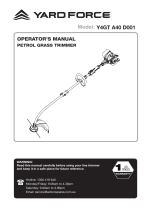
Operating manual English
5
Keep your body, and in particular
your hands, warm in cold
weather. Working with under-
cooled hands is the main
contributing factor!
Take regular breaks and move
your hands. This will stimulate
your blood circulation.
Safety instructions
for petrol-driven units
Petrol is highly flammable and
the vapours may explode if ignited.
Take the following precautions:
Store petrol in designated and
permitted containers only.
Keep ignition sources away from
spilled petrol. Do not start the
engine until the petrol vapours
have evaporated.
Before filling the tank, always
switch off the engine and leave
it to cool down.
Never remove the tank cap or fill
the tank while the engine is hot.
Before using the unit, ensure
that the tank cap is screwed
on tightly. Slowly unscrew the
tank cap to reduce the pressure
in the tank gradually.
Mix petrol and fill the tank
in a clean, well ventilated outdoor
area only where there are no
sparks or flames.
After switching off the engine,
slowly unscrew the tank cap.
Do not smoke while mixing petrol
or filling the tank. Immediately
wipe any spilled petrol off the
unit.
Before switching on the engine,
carry the unit at least 10 m away
from the filling station.
While filling the tank or using
the unit, do not smoke and keep
sparks and naked flames out
of the area.
Replace damaged exhausts,
fuel tanks, or filler caps.
Operating the unit
Never start the unit and never
leave it running in a closed
room or building. The inhalation
of exhaust gases may be fatal.
Use the unit outdoors only.
Wear eye and ear protection
when using the unit.
If working in a dusty environ-
ment, wear a face or dust mask.
A long-sleeved shirt is recom-
mended. Working without eye or
ear protection may result in
severe eye injuries or loss of
hearing.
Wear thick, long trousers, boots
(anti skid) and gloves.
Do not wear loose clothing,
jewellery, short trousers, sandals
and do not walk barefoot.
Pin your hair above your shoul-
ders. If required, wear a hair net.
The cutting attachment cover
must always be attached when
you use the unit as a lawn
trimmer. Both trim lines must
be pulled out and the correct line
must be installed.
The trim line must not be pulled
out over the end of the cover.
The unit has a clutch.
The cutting attachment stops
when the unit is running at no
load. If it does not stop, have
the unit adjusted by a mechanic
at your authorised dealer.
Before switching on the unit,
ensure that line spool/cutting
blade cannot strike an object.
Adjust the hand grip to match
your size so that you can hold the
unit firmly.
Operate the unit in daylight or
adequate artificial lighting only.
Avoid starting the unit uninten-
tionally. Be ready to operate
the unit when you pull the starter
rope. User and unit must be in
a stable position when the unit
is started. Follow the Start/Stop
instructions.
Use this unit for its designated
purpose only.
Do not stretch too far over
the unit. Always have a secure
footing and keep your balance.
When operating the unit, always
hold the unit firmly with both
hands: One hand on the throttle
handle, the hand on the grip.
When operating the unit, always
wear the shoulder belt.
Do not use the unit in adverse
weather conditions, e.g. if there
is a probability of rain or a storm.
Never change the engine
settings preset at the factory.
Keep away from naked flames,
avoid creating sparks and do not
smoke.
Never operate the unit with
a defective ignition switch.
Keep your hands, face and feet
away from all moving parts.
Do not touch the cutting attach-
ment while it is rotating and
do not attempt to stop it.
Do not touch the engine or
muffler. These parts become very
hot while the unit is being used.
They remain hot for a short time
even when the unit is switched
off.
Do not let the engine run quicker
than required for cutting
or trimming of lawn edges.
Do not run the engine at high
speed when it is not cutting.
Always switch off the engine
if you cannot start cutting
immediately or if you are moving
from one place to another.
When working, frequently
change your working position
and have a break every so often
so that you can maintain your
performance.
If unusual vibrations occur,
switch off the engine immedia-
tely. Check the unit for damage.
If the unit is damaged, contact
a specialist workshop.
If you strike or ensnare a foreign
object, immediately switch
off the engine and check whether
the unit has been damaged.
Never use the unit with loose
or damaged parts.
Before removing blockages
or performing other work on the
unit, switch off the engine and
remove the spark-plug terminal.
Stop and switch the engine off
before performing maintenance
or repairs or before changing
cutting attachments.
Also pull out the spark-plug
terminal.
Use only original spare parts
for repairs.
These parts can be purchased
from your authorised dealer.
















